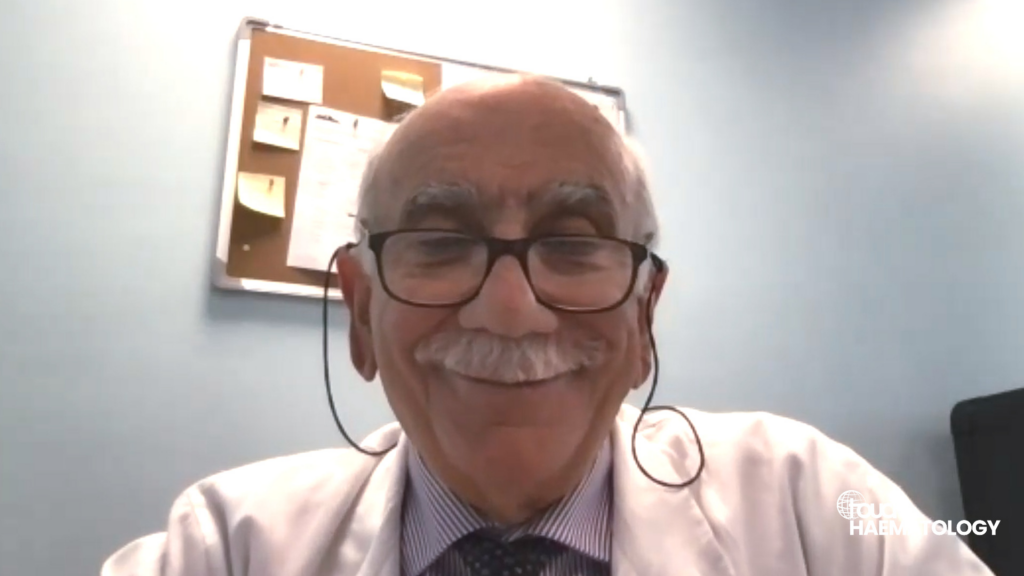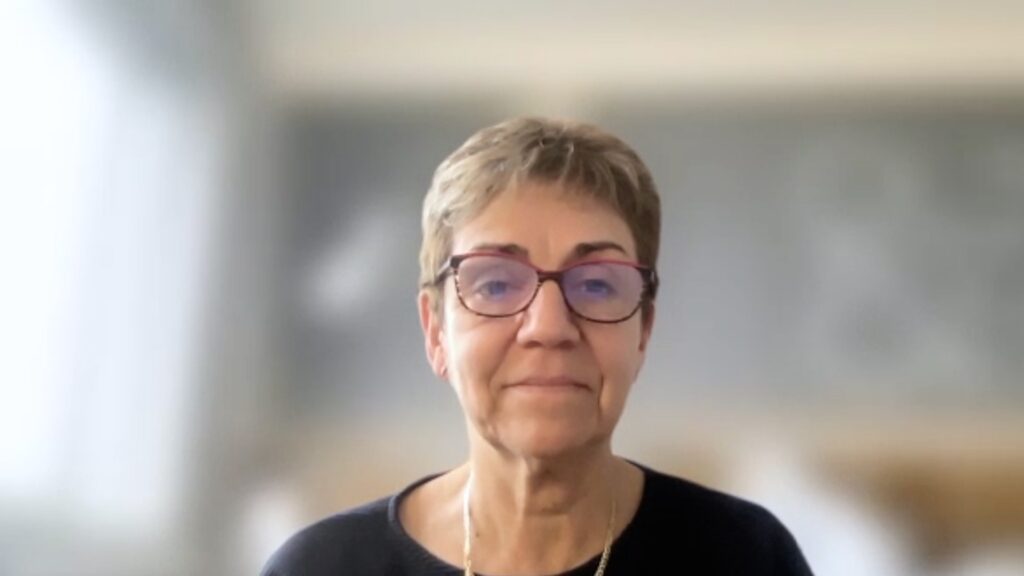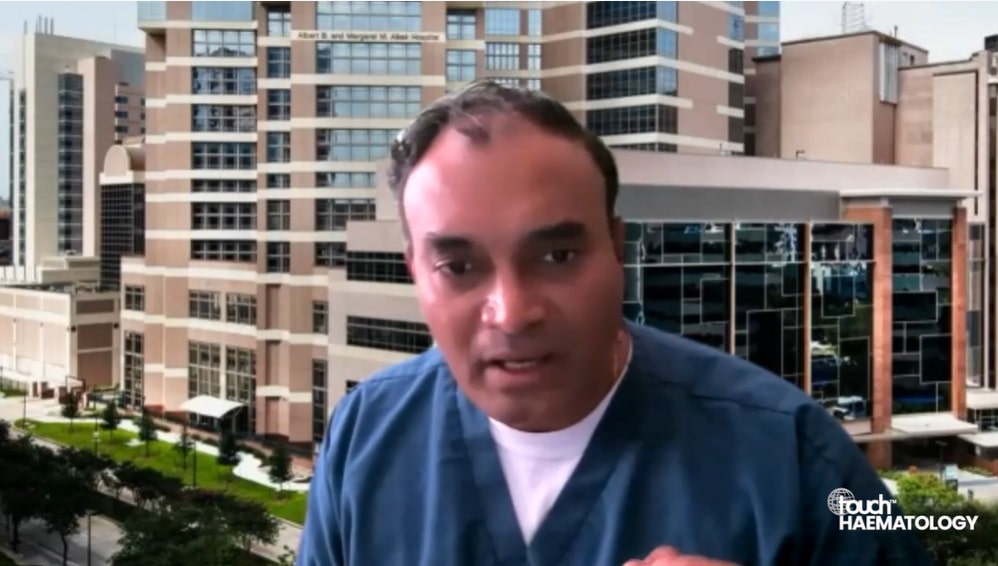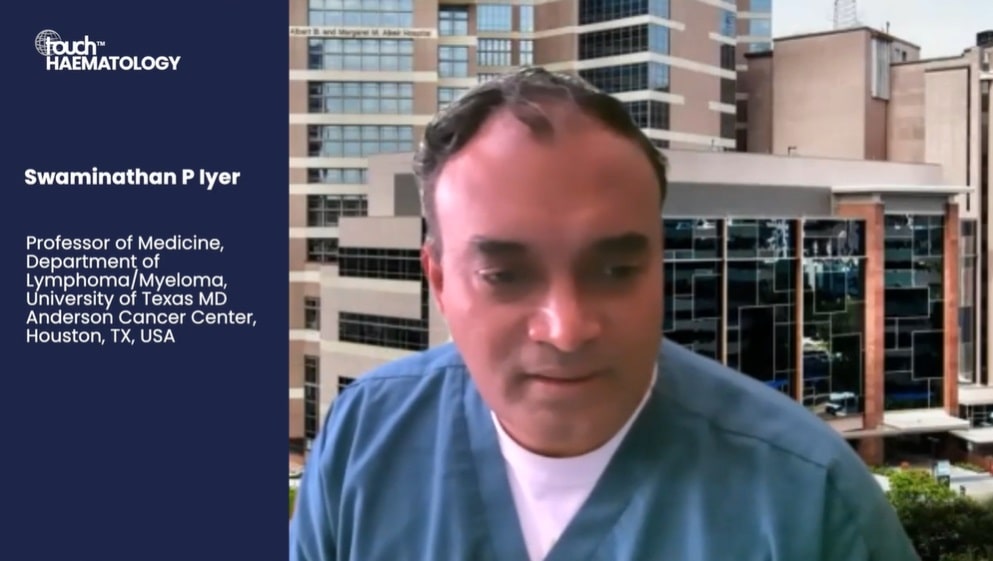Dr William Townsend shares the latest data from the final analysis of the phase III GALLIUM study in patients with follicular lymphoma, which used the glycoengineered type II anti-CD20 monoclonal antibody obinutuzumab plus chemotherapy . The study compared rituximab-based chemotherapy with obinutuzumab-based chemotherapy in patients with previously untreated advanced-stage follicular lymphoma.
The abstract ‘OBINUTUZUMAB PLUS CHEMOTHERAPY DEMONSTRATES LONG-TERM BENEFIT OVER RITUXIMAB PLUS CHEMOTHERAPY IN PATIENTS WITH PREVIOUSLY UNTREATED FOLLICULAR LYMPHOMA: FINAL ANALYSIS OF THE GALLIUM STUDY’ (Abstract: S206) was was presented at the EHA2022 Congress, 9-12 June 2022.
- What are the unmet needs in the first-line treatment of patients with follicular lymphoma? (00:30-01:50)
- Could you give us a brief overview of the GALLIUM study and its efficacy and safety findings? (01:50-06:13)
- What have we learned from the final analysis of the GALLIUM study? (06:13-07:22)
- Which patients are most likely to benefit from obinutuzumab and in whom is it contraindicated? (07:22-08:35)
Disclosures: William Townsend is on the advisory board for: BMS, Roche and Takeda, and has received honoraria/honorarium from: BMS, Gilead, Incyte, Roche and Takeda.
Support: Interview and filming supported by Touch Medical Media Ltd. Interview conducted by Sophie Nickelson originally for touchONCOLOGY.com
Filmed in coverage of the 27th Congress of the European Hematology Association (EHA)
Transcript
My name is Dr William Townsend. I’m a consultant haematologist at University College Hospital in Central London, where I specialize in lymphoma. And I was a clinical research fellow working on the GALLIUM trial for many years and have been involved in the trial ever since. And I’m really pleased, was really pleased to present the final data of the final analysis at the Eha Congress in Vienna earlier this year.
What are the unmet needs in the first-line treatment of patients with follicular lymphoma? (00:30-01:50)
OK so it’s clear from these results from the gallium trial, which really corroborate the results from the primary analysis, that obinutuzumab in combination with chemotherapy in the frontline treatment of follicular lymphoma, offers a significant advantage over rituximab plus chemotherapy that advantages is in an improvement in progression free survival and also in the clinically meaningful time to next treatment. So patients in the obinutuzumab arm had longer until they needed a second dose subsequent line of therapy. There’s also a few early progressions and we increasingly from follicular lymphoma studies that early progressions are important to avoid because of their association with reduced overall survival. So this fewer early progressions are part of 24 events. It’s also evidence that patients in the obinutuzumab arm achieved deeper remissions. and we see from some data from this longer term follow up that those patients who achieved PET-negative remissions in the obinutuzumab arm have the best outcomes in the trial.
Could you give us a brief overview of the GALLIUM study and its efficacy and safety findings? (01:50-06:13)
The design of this trial will be known to many. It’s a large international randomized trial. 12,000 patients with untreated follicular lymphoma who need a treatment according to GELF criteria. Randomized 1 to 1 to either obinutuzumab plus chemo or rituximab plus chemo. Chemo backbone not randomized. So the chemo backbone was chosen by sense, whether bendamustine, chok or kVp at the start of the trial. So the randomization was between the antibody that was paired with those chemo backbones. Patients who responded after their 6 to 8 cycles of induction therapy received two years of antibody maintenance therapy with the same antibody that they received during induction. So that’s the study design. Primary endpoint was progression free survival. We know with the primary analysis that there was a significant improvement in progression free survival in the obinutuzumab arm with the hazard ratio at that time of about three years follow up of 0.66. In these data presented EHA earlier this year, with almost eight years follow up, the seven year progression free survival is 63% in the obinutuzumab arm versus 55% in the rituximab arm. The hazard ratio is 0.77 with a p-value 0.006. So highly in favor of a obinutuzumab are with this longer follow up. I think other important results to come out of this longer follow up: we see in a sub analysis the preplanned sub analysis that the benefit seems to be limited to those with an intermediate or high risk FLIPI score and that there is no clear benefit of obinutuzumab over rituximab in the low risk 50 patients, that’s patients with a FLIPI of 0 to 1. So as well as the primary endpoint of progression free survival, we also see that time to next treatment is significantly improved in the obinutuzumab arm with almost 3/4 of patients in the obinutuzumab arm still not having received further line of treatment at 7 years, compared to 65% in the rituximab hazard ratio for that outcome is 0.71, with a P value of 0.001. I think that’s really meaningful for patients because in this disease in which we think that relapse is almost inevitable in all patients time. And so they need a next line of treatment is really clinically meaningful to patients. A few other highlights from this longer analysis. The PET data, so this the largest study of PET in frontline treatment of follicular lymphoma. And we see in these data the patients who achieve a PET negative remission have significantly improved, both progression free and overall survival compared to those who don’t achieve PET-negative remission. And we see that patients who achieve a PET negative remission in the obinutuzumab arm have significantly better PFS than those who achieved PET negative remission in the rituximab arm. Really highlighting that getting that deeper remission with obinutuzumab appears to confer significant benefit. Safety data very briefly. Really, there’s no new signal from the safety data with this longer follow up, which is very reassuring. There is a small increase in the number of grade 3 adverse events, especially grade 3 infections with longer follow up. But this difference is small, and it’s very reassuring to see that there are near identical rates of fatal adverse events in the two arms. There have been 26 fatal events in the obinutuzumab arm, 27 in the rituximab arm with this longer follow up. And one of the findings from the original analysis was the surprisingly high rate of fatal events in patients treated with bendamustine at about 5%, and we see with this longer follow up that rate has not significantly changed, and importantly, that the rates of fatal events in patients treated with bendamustine is near identical between the rituximab and the obinutuzumab arm. So this appears to be an effect of the chemo backbone rather than the antibody with which it’s paired.
What have we learned from the final analysis of the GALLIUM study? (06:13-07:22)
So we’ve learned from the final analysis of the follicular lymphoma patients in the GALLIUM study that the primary outcome and the primary results that were presented at three years follow up have broadly been maintained with longer follow up. So this is reassuring to see that the benefit achieved with obinutuzumab arm is sustained with longer follow up. And that’s the real key finding here. The other findings, I think, are also reassuring and really confirm the primary analysis in that as well as progression free survival. We see prolongation of time to next treatment. We don’t see any emergence of a significant difference in overall survival. But of course, the trial was not powered to look for an overall survival difference, which is famously hard to detect in frontline treatment of follicular lymphoma. I think we’re reassured that there’s no new safety signal. And of course, the PET data are very intriguing. And I think this study really highlights the importance of achieving a PET negative remission with frontline therapy.
Which patients are most likely to benefit from obinutuzumab and in whom is it contraindicated? (07:22-08:35)
The prespecified subgroup analysis really highlighted that broadly speaking, obinutuzumab was superior to rituximab in most subgroups. The one difference, and I touched on this already, would be in those patients with a low FLIPI score. So that’s where the flip score is 0 or 1. That doesn’t appear to be a significant benefit and progression free survival in that cohort of patients. So certainly where I practice, we limit, we restrict obinutuzumab to those patients with an intermediate or high FLIPI score. I know that will be different in different countries, but I think that’s a reasonable approach to take. And we know that there is a slight increase in toxicity with obinutuzumab. Personally, I think that increase is manageable and acceptable, especially in those patients with a higher risk. So the intermediate or high FLIPI patients. I don’t think we’ve identified anyone in whom it’s contraindicated. Beyond, of course, patients who have hypersensitivity reactions, etc. and then whom in whom it would not be appropriate to give.
Interested in more content on lymphoma? Here is some of our latest content:







